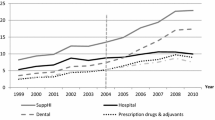Abstract
In 1995 dental services were excluded from the compulsory health insurance package that covers the families of all Dutch employees in the market sector with incomes below a certain threshold. People had to choose between no insurance and supplementary insurance. The exclusion of dental services was unexpected and was accompanied by a generous acceptance policy and almost uniform premiums. Due to these features the exclusion constitutes a natural experiment to investigate whether customers with poorer teeth conditions are more likely to buy insurance. This is a key condition for adverse selection to matter. The empirical results show that adverse selection indeed occurs; individuals with poor teeth condition are more likely to choose insurance. The same holds for customers with more frequent visits in the past. Differences in prices play some role, whereas differences in income do not.
Similar content being viewed by others
REFERENCES
Cameron, A.C. and P.K. Trivedi (1991), ‘The Role of Income and Health Risk in the Choice of Health Insurance; Evidence from Australia,’ Journal of Public Economics, 45, pp. 1–28.
Cramer, J.S. (1991), The LOGIT Model: An Introduction for Economists, London, Edward Arnold.
Geurts, J.J.M. and F.F.H. Rutten (1987), ‘Tot de tanden verzekerd; de verzekeringskeuze voor tandheelkundige hulp nader onderzocht,’ Nederlands Tijdschrift Tandheelkunde, 94, pp. 287–291.
Kalsbeek, H., G.J. Truin, G.M.J.M. van Rossum, H.M. van Rijkom, J.H.G. Poorterman and G.H. Verrips (1998), ‘Trends in Caries Prevalence in Dutch Adults between 1983 and 1995,’ Caries Research, 32, pp. 160–165.
Marquis, M.S. (1992), ‘Adverse Selection with a Multiple Choice among Health Insurance Plans: A Simulation Analysis,’ Journal of Health Economics, 11, pp. 129–151.
Marquis, M.S. and C.E. Phelps (1987), ‘Price Elasticity and Adverse Selection in the Demand for Supplementary Health Insurance,’ Economic Inquiry, 25, pp. 299–313.
Neipp, J. and R.J. Zeckhauser (1985), ‘Persistence in the Choice of Health Plans,’ in: R.M. Schleffler and L.F. Rossiter (eds.), Advances in Health Economics and Health Services Research, Volume 6. Biased Selection in Health Care Markets, Greenwich, CT, JAI Press.
Newhouse, J.P. (1996), ‘Reimbursing Health Plans and Health Providers: Efficiency in Production versus Selection,’ Journal of Economic Literature, 34, pp. 1236–1263.
Rothschild, M. and J. Stiglitz (1976), ‘Equilibrium in Competitive Insurance Markets: An Essay on the Economics of Imperfect Information,’ Quarterly Journal of Economics, 90, pp. 629–649.
Salanié, B. (1997), The Economics of Contracts, Cambridge/London, MIT Press.
Swinkels, H. and J. Maessen (1996), ‘Het gebruik van tandheelkundige voorzieningen naar sociaaleconomische status tussen 1981 en 1995,’ Maandbericht Gezondheid, CBS 96/4.
Wolfe, J.R. and J.H. Goddeeris (1991), ‘Adverse Selection, Moral Hazard, and Wealth Effects in the Medigap Insurance Market,’ Journal of Health Economics, 10, pp. 433–459.
Ziekenfondsraad (1995), Evaluatie Beperking Aanspraken Tandheelkunde, No. 671.
Rights and permissions
About this article
Cite this article
Godfried, M., Oosterbeek, H. & van Tulder, F. Adverse Selection and the Demand for Supplementary Dental Insurance. De Economist 149, 177–190 (2001). https://doi.org/10.1023/A:1017566901875
Issue Date:
DOI: https://doi.org/10.1023/A:1017566901875




